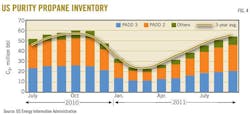P. 4 ~ Continued - US PROPANE — MIDYEAR 2011: US propane trade undergoes historic changes; more likely
View Article as Single page
Inventory trends
Propane inventory (excluding propylene inventory included in EIA gross propane/propylene inventory data) in primary storage in the US was 22.5 million bbl on April 1. EIA statistics from the Petroleum Supply Monthly (PSM) showed inventory increased 22.6 million bbl during April through July 2011 and increased 8-10 million bbl during August and September 2011. The seasonal build in US for 2011 was 31.4 million bbl. During 2008-2010, the seasonal inventory build was 33.5 35.0 million bbl.
At the beginning of winter 2011/2012, inventory in the US totaled 53.5 54.0 million bbl. During second-quarter 2011, inventory was 5-7 million bbl below year earlier volumes. At this year's seasonal peak, the inventory deficit compared with 2010 had narrowed to 3.7 million bbl due to the slump in propane exports in September and October.
Propane inventory in Canada typically begins to increase in March, but inventory in 2011 continued to decline in March and the seasonal recovery began in April. During April through August, statistics from Canada's National Energy Board showed inventory in Canadian storage increased 8.2 million bbl and totaled 11.5 million bbl on Sept. 1.
Historically, inventory in Canadian storage often begins its seasonal decline during September. In 2010, however, inventory reached its seasonal peak on Oct. 1. For 2011, due to the late summer slump in propane exports, inventory in Canadian storage continued to increase in September and reached a peak of 12.0-12.5 million bbl.
NEB also reports the breakout of purity propane inventory compared with propane contained in unfractionated mix. NEB statistics showed purity propane inventory in Canada totaled 9.0 million bbl on Sept. 1. At this volume, purity propane inventory was 600,000 bbl lower than in 2010. We estimate purity propane inventory reached a peak of 10 million bbl on Oct. 1, 2011.
For North America, inventories totaled only 26.6 million bbl on Apr. 1, 2011, and were 4.6 million bbl less than in 2010. By Sept. 1, 2011, inventories on a North America basis had increased to 64.5 million bbl and were 6.3 million bbl less than in 2010.
Markets in North America have the twin levers of reducing ethylene feedstock demand or exports or both to avoid the risk that imports will fall below historic minimum levels before Mar. 1. If inventory falls below the historic low of 24.2 million bbl, historians will have another reason to note the importance of this winter heating season.
Fig. 4 shows trends in propane inventory in US storage.
PADD: US Petroleum Administration for Defense Districts*PAD District 1 (East Coast) consists of three subdistricts: • Subdistrict 1A (New England): Connecticut, Maine, Massachusetts, New Hampshire, Rhode Island, Vermont. • Subdistrict 1B (central Atlantic): Delaware, District of Columbia, Maryland, New Jersey, New York, Pennsylvania. • Subdistrict 1C (lower Atlantic): Florida, Georgia, North Carolina, South Carolina, Virginia, West Virginia. PAD District 2 (Midwest): Illinois, Indiana, Iowa, Kansas, Kentucky, Michigan, Minnesota, Missouri, Nebraska, North Dakota, South Dakota, Ohio, Oklahoma, Tennessee, Wisconsin. PAD District 3 (Gulf Coast): Alabama, Arkansas, Louisiana, Mississippi, New Mexico, Texas. PAD District 4 (Rocky Mountain): Colorado, Idaho, Montana, Utah, Wyoming. PAD District 5 (West Coast): Alaska, Arizona, California, Hawaii, Nevada, Oregon, Washington.. *PADDs were delineated during World War II to facilitate oil allocation. Source: US Energy Information Administration, Washington |
Regional inventory
EIA statistics (Table 2) showed inventory in primary storage in Petroleum Administration for Defense District (PADD) 2 (see box) fell to a low of 9 million bbl on Apr. 1, 2011. At this volume, inventory was 1.1 million bbl lower than in 2010. EIA monthly statistics show inventory increased by 15-16 million bbl during 2007-10 and increased 18.5 million bbl during 2009.
Based on EIA's final monthly statistics and weekly estimates, inventory increased by 16.5 million bbl and peaked at 25.5 million bbl on Oct. 1, 2011. Inventory increased at below-average rates during second-quarter 2011 and was 3-4 million bbl below 2010 levels. Inventory build rates during August, however, were more than double the historic average according to EIA weekly estimates and the build in August eliminated the deficit compare with 2010.
Inventory in primary storage in PADD 3 (excluding nonfuel propylene) fell to a low of 11.1 million bbl on Apr. 1, 2011. EIA's final monthly statistics showed inventory builds during April through July totaled 7.5 million bbl. Build rates were below average during this period.
The weakness in build rates was not surprising since waterborne exports were consistently 100,000 b/d or more during this period. EIA's weekly inventory estimates showed inventory increased by about 2.3 million bbl during August and September and total 21.0 21.5 million bbl on Oct. 1.
During April through July, the inventory deficit in PADD III widened to 5 million bbl. The inventory deficit widened to 8-9 million bbl on Oct. 1.
Displaying 3/6
View Article as Single page


